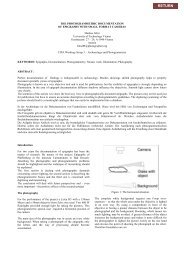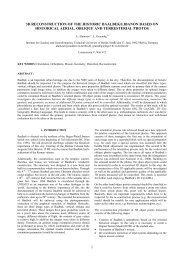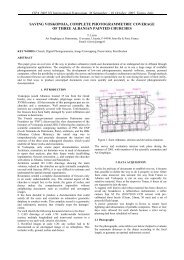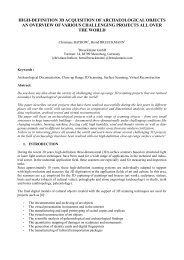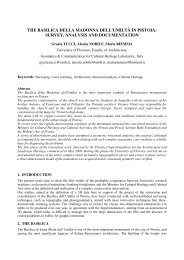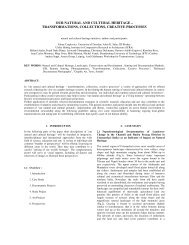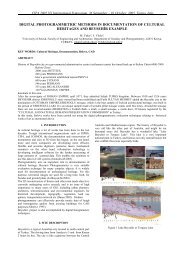CIPA HERITAGE DOCUMENTATION - CIPA - Icomos
CIPA HERITAGE DOCUMENTATION - CIPA - Icomos
CIPA HERITAGE DOCUMENTATION - CIPA - Icomos
You also want an ePaper? Increase the reach of your titles
YUMPU automatically turns print PDFs into web optimized ePapers that Google loves.
1<br />
1.1 State-of-the-Art<br />
Introduction<br />
to Heritage Documentation<br />
P. Patias 1 , M. Santana 2<br />
1. Aristotle University of Thessaloniki, Department of Cadastre, Photogrammetry and Cartography,<br />
Univ. Box 473, GR-54124 Thessaloniki, patias@auth.gr<br />
2. Department of Architecture, Urban and Regional Planning - R.Lemaire International Center<br />
for Conservation - University of Leuven (KU Leuven), president@cipa.icomos.org<br />
Cultural documentation is a complicated process, and includes<br />
a wide suite of activities that include surveying, testing<br />
and monitoring and gathering textual and other information.<br />
“The geometry of the object is not the only parameter to be recorded.<br />
All specificities making the object unique are meaningful;<br />
all potential values – architectural, artistic, historical,<br />
scientific and social – are parameters to consider”, (D’Ayala<br />
and Smars, 2003).<br />
The guiding concepts of cultural heritage documentation<br />
have been detailed by D’Ayala and Smars (2003) (Patias,<br />
2007) as:<br />
➧ Objectivity: “… an objective basis is a guarantee to having<br />
a firm ground on which to debate the conservation choices…”<br />
and “…the use of any specific set of data necessarily<br />
influences any decision-making process. The manner in<br />
which a survey is executed significantly influences further<br />
actions”.<br />
➧ Values: “The recorder’s choices are critical…… What is<br />
seen today as uninteresting may appear tomorrow as extremely<br />
valuable. The importance of thorough recording is<br />
emphasised by the common loss of minor details which<br />
may disappear at the moment of new conservation work,<br />
leading to loss of integrity or of historical evidence.”<br />
➧ Learning process.<br />
➧ Continuity: “… Documentation should not be seen as an<br />
activity confined within a set time…. Therefore, a basic requirement<br />
is that the results of documentation should be<br />
available for future use.”<br />
➧ Fabric: “Documentation should not stop at the surface....<br />
Integration with other documentation techniques is necessary.”<br />
➧ Documentation sets: “Information gathered during documentation<br />
may be large and manifold…. thus it is critical to<br />
organise the available information, for which the metric<br />
survey is a natural support. Sets of thematic drawings (geometry,<br />
materials, pathologies etc.) can be prepared. A<br />
specific set prepared by one specialist can bring insight to<br />
other specialists who are working on other sets.”<br />
➧ Redundancy: “… Every piece of information is associated<br />
with uncertainty. Documentation data should be supplemented<br />
by information about the quality of the data. Control<br />
procedures offer a way to assess quality.”<br />
These concepts lead to increasing needs for recording and<br />
documentation of CH, which put briefly are:<br />
➧ recording of a vast amount of four dimensional (i.e. 3-D<br />
plus time) multisource, multi-format and multi-content information,<br />
with stated levels of accuracy and detail;<br />
➧ digital inventories in 3-D and, as far as available, dated historical<br />
images;<br />
➧ management of the 4-D information in a secure and rational<br />
way, making it available for sharing and distribution to<br />
other users; and<br />
➧ visualization and presentation of the information in a userfriendly<br />
way, so that different kinds of users can actually retrieve<br />
the data and acquire useful information, using Internet<br />
and visualization techniques.<br />
<strong>CIPA</strong>’s main objective is to provide an international focal<br />
point for efforts in the improvement of all methods for surveying<br />
of cultural monuments and sites. The combination of all<br />
aspects of photogrammetry with other surveying methods is<br />
regarded as an important contribution to recording and monitoring<br />
cultural heritage, to the preservation and restoration of<br />
any valuable architectural or other cultural monument, object<br />
or site, and to provide support to architectural, archaeological<br />
and other art-historical research.<br />
1. IntroductIon to HerItage documentatIon<br />
9



